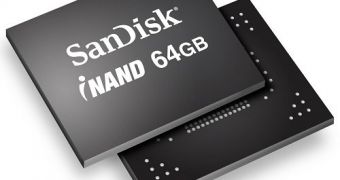It appears that makers of NAND Flash memory chips are quite bent on advancing their technologies as quickly as possible, Toshiba and SanDisk being among those that seem to be moving fastest in this respect.
As is the case with all semiconductors, the more advanced the manufacturing process, the better they are overall.
Making a transition to a smaller node always ensures a higher energy efficiency, in addition to better performance and lower manufacturing costs.
Over the past year, quite a few chip makers moved on to more advanced nodes, this including SanDisk, Toshiba, Samsung, etc.
Now, it appears that SanDisk and Toshiba are both working towards setting up their 10nm manufacturing technologies, or so reports say.
As end-users will no doubt be unsurprised to hear, demand for flash memory is growing on the mobile device market.
As such, the two companies will accelerate production of MLC (multi-level cell) two-bits-per-cell and three-bits-per-cell NAND Flash memory.
"Our primary operating expense investments in 2011 will be in research and development, and we will include Fab 5 start up costs, as well as technology investment in [10nm-class] NAND and beyond," said Judy Bruner, chief financial officer of SanDisk Corp., during a conference call with financial analysts.
For those interested in such things, SanDisk reached revenues of $1.33 billion in the quarter ended January 2, 2011, meaning a 7% on-year increase and 8% sequential rise.
This led to a total revenue of $4.83 for fiscal year 2010, which was 35% higher than the 3.57 billion of FY 2009.
The above mentioned transition is no doubt intended to further propel its business, so that the financial results of fiscal year 2011 end up better overall.
Basically, in order to ensure lower costs per bit (this is what thinner process technologies are basically for), transitions should be made quite aggressively this year.

 14 DAY TRIAL //
14 DAY TRIAL //